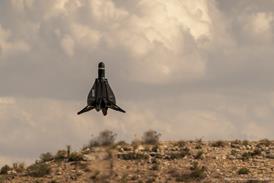Airbus says the successful trial in February of an electrically activated braking system (EABS) on its A340-600 development aircraft could pave the way for use of the technology in a next-generation airliner that follows the A350 XWB in development.
The airframer is claiming a technical world first following the 13 February flight trial on the A340, as it was the first time an electrical braking system has been flown on a large commercial aircraft, says Airbus.
The EABS research and technology study is being undertaken with brake supplier Messier-Bugatti. The effort was launched in 2007 when initial ground trials began.
"We began evaluating the system on the A340-600 gear test rig at the Airbus UK's plant in Filton last June," says Airbus's head of wheels, tyres and brakes Dominic Anderson.
For the flight test, the EABS replaced the A340's conventional hydraulically activated brake system on all four wheels on its centre landing gear.
"The conventional actuators were replaced by electro-mechanical actuators - five per wheel. These were connected by an electrical loom running down the leg, which provided power and control from electric brake controllers [EBCs] mounted in the fuselage," says Anderson.
"The EBCs, which are a series of power electronic boxes that convert 115V AC to 270V DC, are connected to the brake and steering control unit installed in the avionics rack below the cockpit," he adds.
During the test flight the A340 undertook a series of braked landings and rejected take-offs, all of which were successful, says the manufacturer.
Airbus says the EABS is an ongoing research effort for potential future applications, but is not planned for the A350, which will have hydraulically activated brakes.
"It is part of our studies into technology for the move to a more-electric aircraft," the manufacturer says. "Benefits of EABS will be enhanced dispatchability, health monitoring, quicker system installation and repair time, which will result in a potentially lower cost of ownership."
The EABS test was run in parallel with a month-long trial on the A340-600 to reduce cabin noise, dubbed "LINFaN" (Low Interior Noise Fan Nozzle). This is a collaborative programme with Rolls-Royce in which the A340's No 3 Trent 500 engine has been fitted with a modified chevron-shaped aft cowling.
Source: FlightGlobal.com























